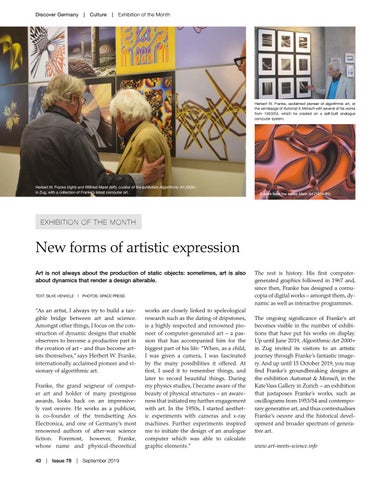Discover Germany | Culture | Exhibition of the Month
Herbert W. Franke, acclaimed pioneer of algorithmic art, at the vernissage of Automat & Mensch with several of his works from 1953/54, which he created on a self-built analogue computer system.
Herbert W. Franke (right) and Wilfried Maret (left), curator of the exhibition Algorithmic Art 2000+ in Zug, with a collection of Franke’s latest computer art.
A work from the series Math Art (1979-85).
E X HIBITIO N OF THE MON TH
New forms of artistic expression Art is not always about the production of static objects: sometimes, art is also about dynamics that render a design alterable. TEXT: SILKE HENKELE I PHOTOS: SPACE PRESS
“As an artist, I always try to build a tangible bridge between art and science. Amongst other things, I focus on the construction of dynamic designs that enable observers to become a productive part in the creation of art – and thus become artists themselves,” says Herbert W. Franke, internationally acclaimed pioneer and visionary of algorithmic art. Franke, the grand seigneur of computer art and holder of many prestigious awards, looks back on an impressively vast oeuvre. He works as a publicist, is co-founder of the trendsetting Ars Electronica, and one of Germany’s most renowned authors of after-war science fiction. Foremost, however, Franke, whose name and physical-theoretical 40 | Issue 78 | September 2019
works are closely linked to speleological research such as the dating of dripstones, is a highly respected and renowned pioneer of computer-generated art – a passion that has accompanied him for the biggest part of his life: ”When, as a child, I was given a camera, I was fascinated by the many possibilities it offered. At first, I used it to remember things, and later to record beautiful things. During my physics studies, I became aware of the beauty of physical structures – an awareness that initiated my further engagement with art. In the 1950s, I started aesthetic experiments with cameras and x-ray machines. Further experiments inspired me to initiate the design of an analogue computer which was able to calculate graphic elements.”
The rest is history. His first computergenerated graphics followed in 1967 and, since then, Franke has designed a cornucopia of digital works – amongst them, dynamic as well as interactive programmes. The ongoing significance of Franke’s art becomes visible in the number of exhibitions that have put his works on display. Up until June 2019, Algorithmic Art 2000+ in Zug invited its visitors to an artistic journey through Franke’s fantastic imagery. And up until 15 October 2019, you may find Franke’s groundbreaking designs at the exhibition Automat & Mensch, in the Kate Vass Gallery in Zurich – an exhibition that juxtaposes Franke’s works, such as oscillograms from 1953/54 and contemporary generative art, and thus contextualises Franke’s oeuvre and the historical development and broader spectrum of generative art. www.art-meets-science.info
